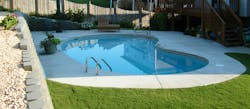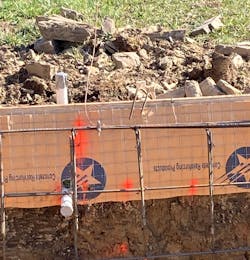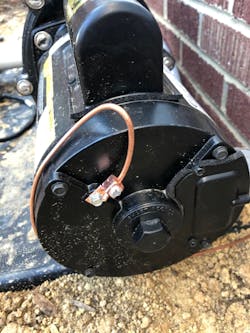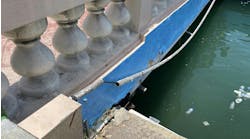Author’s Note: The 2023 NEC contains significant changes to Art. 680 Swimming Pools, Fountains, and Similar Installations. These changes incorporated public input and comments submitted during the revision cycle as well as a recent tentative interim amendment (TIA) issued by the NFPA Standards Council. TIA 23-9, issued on March 21, 2023, with an effective date of April 10, 2023, revised the definition of a pool while also changing requirements in Sec. 680.26 Equipotential Bonding.
Article 680 of the NEC provides installation guidance associated with various types of pools, spas, tubs, bathtubs, and lifts. The Article is divided into eight parts. Part I contains general requirements that describe the overall scope of the Article. Parts II through VIII provide Code users with general requirements that pertain to their specific type of installation.
To properly apply Code requirements, it is essential to understand various defined terms located in Art. 100 of the 2023 NEC. For instance, “permanently installed pools” are now defined as those that are constructed or installed in the ground or partially in the ground. This also includes all pools installed inside of a building — whether or not served by electrical circuits. Note the revised NEC edition no longer specifies that the pool must hold water in a depth greater than 42 in. A “fountain” is described as an ornamental structure or recreational water feature where one or more jets or streams of water are discharged into the air. A “splash pad” is described as a type of fountain intended for use by pedestrians and designed to contain a maximum of 1 in. of water. Additionally, the definition of a “pool” has been revised to exclude bodies of water such as lakes, lagoons, surf parks, or other natural or man-made bodies of water that may include swimming areas.
Section 680.50 of Part V provides guidance that fountains having water common to a pool and splash pads must comply with the equipotential bonding requirements. Specific information relating to equipotential bonding requirements is found in Sec. 680.26 of Part II, which addresses permanently installed pools. Please note that for the remainder of this article, the word “pool” will be used as an all-encompassing term that includes a permanently installed pool, fountain with water common to a pool, and splash pad — all of which require equipotential bonding in compliance with Sec. 680.26.
Deep dive into Sec. 680.26 of Part II
Section 680.26 indicates that equipotential bonding shall be installed to reduce voltage gradients in the pool area. Voltage gradients, which can also be described as the difference in voltage between the conductive parts associated with a pool found in Sec. 680.26(B)(1) through (7), can exist for a variety of reasons. The premises wiring system of a structure can leak voltage to the ground and conductive pool parts when not installed, maintained, or grounded in compliance with industry codes and standards. Electric utilities can also cause voltage gradients by leaking voltage into the ground due to conditions such as compromised insulation or ground paths. Residual voltage from lightning strikes as well as static electricity can also create voltage gradients in the pool area.
The requirement to install equipotential bonding and connect all the conductive parts described in (B)(1) through (7) together mitigates the voltage gradient by putting these parts at the same voltage potential. Although the voltage is not eliminated, connecting all the conductive parts together distributes the voltage evenly — and thus greatly reduces the likelihood of someone getting shocked. All conductive parts in (B)(1) through (7) must be bonded together by using one of three options (either separately or in combination): a solid copper conductor, no smaller than 8 AWG that can be insulated, covered, or bare; a rigid metal conduit of brass; or another identified corrosion-resistant metal.
Note the purpose of equipotential bonding differs from that of grounding and bonding to comply with Art. 250 requirements. Sections 250.4(A)(2) Grounding of Electrical Equipment and (3) Bonding of Electrical Equipment distinguish this difference. Grounding is installed to limit the voltage imposed by lightning, line surges, or unintentional contact with higher voltage lines. Bonding is installed to establish an effective ground-fault current path back to the source. Additionally, Sec. 250.52(B) states that the pool structure and structural rebar is not permitted to be used as a grounding electrode.
List item (1) in 680.26(B) addresses the conductive pool shell and provides two bonding options: structural reinforcing steel or a copper conductor grid. If the pool is formed with structural reinforcing steel, the steel is required to be bonded together by steel tie wires or the equivalent. If the structural steel is encapsulated in a nonconductive compound, a copper conductive grid that complies with 680.26(B)(1)(b) must be installed. The Code also reiterates that concrete — whether cast in place, pneumatically applied, sprayed, or block — is all considered conductive. Materials such as vinyl liners and fiberglass composite shells are not considered conductive.
List item (2) addresses the perimeter surface that surrounds the pool, and TIA 23-9 created significant changes to these requirements. First, the perimeter surface now extends 3 ft horizontally from the inside wall of the pool as well as 3 ft above and 2 ft below the maximum water level. This includes surfaces such as concrete, pavers, tile, grass, or dirt. There are four bonding options: structural reinforcing steel, steel structural welded wire reinforcement (sometimes also referred to as “wire roll out” or “steel wire mesh roll”), a copper conductor, or a copper grid. A conductive pool shell bonded to a perimeter surface is required to be attached to the pool reinforcing steel or copper conductor grid at a minimum of four points uniformly spaced around the perimeter of the pool.
In installations where the bonded perimeter surface does not surround the entire pool, the perimeter surface is required to be attached to the pool reinforcing steel or copper conductor grid at a minimum of four points uniformly spaced along the bonded perimeter surface. An example of this would be a rectangular-shaped pool where one of the four sides is constructed with a vanishing edge, thus eliminating a perimeter surface on that one side. When bonding to a perimeter surface is required for a nonconductive pool shell, bonding at four points is not required, but the perimeter bonding is required to be attached to the equipotential bonding conductor — and, if present, to any conductive support structure for the pool.
List item (2) sub-section (a) is now titled “Conductive Paved Portions of Perimeter Surfaces,” and the requirements have been revised. Conductive paved portions of the perimeter surface are required to be bonded with either unencapsulated structural reinforcing steel or unencapsulated steel structural welded wire reinforcement. If the perimeter surface is absent of reinforcing steel — or the reinforcing steel is encapsulated in a nonconductive compound — unencapsulated welded wire steel reinforcement or a copper conductor grid is required. Both need to be secured directly under the paving and not more than 6 in. below finished grade.
Unencapsulated steel welded wire reinforcement that is not fully embedded in concrete and the copper grid, whether embedded in concrete or not, is required to be listed specifically for corrosion resistance and mechanical performance as of Jan. 1, 2025. The copper grid option is to be constructed of 8 AWG solid bare copper and comply with Sec. 680.26(B)(1)(b)(3). The steel welded wire reinforcement is to be at least ASTM 6x6-W2.0 x W2.0 or No. 3 rebar constructed in a 12-in. grid. Both the copper grid and welded wire must follow the contour of the perimeter surface extending not less than 3 ft horizontally beyond the inside wall of the pool.
List item (2) sub-section (b), newly titled “Unpaved Portions of Perimeter Surfaces,” now also has revised requirements. If a copper conductor is installed, it must have at least one 8 AWG bare solid, including the 8 AWG copper equipotential bonding conductor (if available). The conductor(s) need to follow the contour of the perimeter surface, be located 18 in. to 24 in. from the inside wall of the pool, be installed under the unpaved portion of the perimeter surface 4 in. to 6 in. below the finished grade, and can only be installed in perimeter surfaces not intended to have direct access to swimmers in the pool. If the copper grid or unencapsulated steel welded wire reinforcement options are installed, they must meet the requirements in Sec. 680.26(B)(2)(a) and be located within the unpaved surface between 4 in. to 6 in. below finished grade.
List item (2) sub-section (c) is now titled “Nonconductive Perimeter Surfaces.” Similar to the other sub-sections, it has revised requirements. When nonconductive portions of perimeter surfaces are separated from the earth on nonconducting supports, equipotential bonding is not required. Additionally, when an equipotentially bonded surface supports a perimeter surface that is electrically separated from the pool structure and raised on nonconductive supports, no additional equipotential bonding is required.
List item (2) sub-section (d) is new and titled “Interconnection of Bonded Portions of Perimeter Surfaces.” The language added reminds installers that all equipotentially bonded surfaces are to be interconnected using listed splicing devices or exothermic welding. Also, where a copper wire is installed, it is permitted to encircle the pool for bonding connections to noncontiguous perimeter surfaces.
List item (3) addresses bonding any metallic components of the pool structure not previously mentioned. An example is a structural metallic wall panel of an in-ground pool.
List item (4) addresses underwater lighting. Other than listed low-voltage lighting systems with nonmetallic forming shells, all metal forming shells and mounting brackets of no niche luminaires are required to be bonded. For specific information on luminaires, see Sec. 680.23 where wet niche, dry niche, no niche, and through-wall lighting assemblies are described.
List item (5) addresses metal fittings and requires them to be bonded if they are within or attached to the pool structure. There are three exceptions concerning isolated parts and metallic pool cover anchors that are less than certain dimensions. Isolated parts not over 4 in. in any dimension and that do not penetrate the pool structure more than 1 in. meet one exception. Metallic pool cover anchors 2 in. or less in any dimension, and 2 in. or less in length meet the other exceptions.
List item (6) addresses bonding metal parts of electrical equipment. This includes equipment such as electrically powered pool covers, water circulation, treatment, heating, cooling, or dehumidification, and all electrical equipment installed within 5 ft horizontally from the inside wall of a pool. There is an exception for listed equipment that incorporates an approved system of double insulation.
List item (7) addresses bonding of fixed metal parts installed within 5 ft horizontally from the inside wall of a pool or 12 ft vertically above the maximum water level of a pool, observation stand, tower, platform, or diving structure. This includes fixed metal parts such as door and window frames, fences, awnings, soffits, gutters, and downspouts. An exception exists for a permanent barrier that prevents people from coming into direct contact with the pool.
Section 680.26(C) focuses on the importance of bonding the pool water where none of the bonded parts mentioned above are in direct connection with the pool water. This sometimes happens with a fiberglass or vinyl liner-type pool. In these instances, the pool water is required to be in direct contact with an approved corrosion-resistant conductive surface. This conductive surface must expose at least 9 square inches of surface area to the pool water at all times. It cannot be located where it will be exposed to physical damage or dislodgement during pool activities. Here are a few reminders: Sec. 680.6 requires this conductive surface to be listed, and Sec. 110.3(B) requires listed equipment to be installed and used in accordance with any instructions included in the listing.
Final thoughts
On a warm summer day, there is no better way to cool off than by going for a dip in a pool, but safety must always be a top priority. Equipotential bonding helps mitigate potential shock hazards and voltage gradients while also creating a safer pool environment.
Electrical safety around pools is an ongoing process, as can be seen in the many revisions made to Art. 680 this cycle. Everyone plays a part in making pools safer, with public input currently being sought until Sept. 7, 2023 for the next round of potential Art. 680 modifications. These would be slated for the 2026 edition of the NEC. Further information can be found at www.nfpa.org/70.
Vince Della Croce is a Business Development Manager of Electrical Inspectors for Siemens Smart Infrastructure USA. Licensed in Florida as a master electrician and Washington as an electrical administrator, he holds an Associate of Science degree in Electronic Engineering and Electrical Maintenance Technology from Penn Foster College. Vince is education chairman for the IAEI Southern Section and Florida Chapter, serves on NEC Code Making Panel 17, and is a technical committee member of NFPA 73 Electrical Inspection of Existing Dwellings, NFPA 99 Health Care Facilities, and NFPA 1078 Electrical Inspector Professional Qualifications. He can be reached at [email protected].








